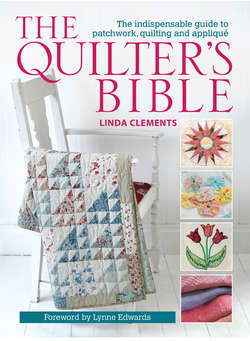Читать книгу The Quilter's Bible - Linda - Страница 73
На сайте Литреса книга снята с продажи.
ОглавлениеMachine Piecing
Machine sewing is a fast, accurate and secure method of piecing patchwork. We all live busy lives yet the need to create something with our own hands is as strong as ever and machine piecing allows us to complete projects in a reasonable time frame. This section describes the basic techniques required for successful machine piecing, and shows how to sew a wide range of seams, which will allow you to piece all sorts of shapes.
When machine piecing bear in mind that seams don’t always have to be hidden. Make a feature of them by sewing patches right sides together so the seams show on the outside. Snip into the seam at intervals and fluff up for a cozy chenille effect.
Setting up the Machine
When beginning a patchwork project, spending a little time preparing the machine for piecing will save time in the long run. The following points should help.
• Insert a new needle for each project and use a Sharps size 80/12 for straight stitching.
• Select a straight stitch with a length of 10–15 stitches per 1in (2.5cm). This forms stitches that are close enough to make a secure stitched line but not so densely packed that the stitches can’t be unpicked if the need arises. For piecing smaller fabric pieces reduce the length to 10–12.
• Use top thread and bobbin thread in colours to match your fabrics or choose neutral shades of grey or beige which will blend with most colours.
• Do some test stitching to check that the machine tension is correct.
• Fill several bobbins to reduce interruptions while piecing.
Starting and Finishing Machine Sewing
There are various ways to start and finish sewing securely and the following are the most popular.
• Start and finish each line of stitching by stitching forwards for a few stitches and then in reverse for a few. Trim the thread ends and feed them into the wadding.
• Start and finish each line of stitching by reducing the stitch length to zero, which means the machine will stitch on the spot. Trim the thread ends and feed them into the wadding.
• Modern machines have a built-in ‘fix’ or ‘secure’ function, which when selected will secure the thread ends. Trim thread ends as before.
• When cutting through seams to make smaller pieces no finishing off is possible. Stitching with a shorter stitch length will help keep stitching secure.
Machine piecing creates a very professional look and a durable finish. This beautiful little bag by Susan Briscoe uses a Log Cabin block in delicate coffee and cream colours.
